Having sonar (AKA "fish-finder") on your boat is no guarantee that you'll actually find fish! Like anything else, sonar is a tool and the more expertise you have with sonar, the better you'll be at using it to find and catch fish.
In this post I will use sonar snapshots from this season and the 2013 season to help share what I know about using sonar effectively. This post should be of value to you if you have sonar but am not 100% confident using it.
Installing The Transducer
I learned firsthand the importance of properly installing sonar when I was in my teens. Back then I tried installing a Raymarine sonar onto my skiff, which I succeeded in doing.
However, I placed the transducer in the wrong spot on my transom, which resulted in lots of "noise" and cavitation readings appearing on my sonar whenever I cruised at a high rate of speed.
I should of spent $100 to get the job done properly by a marine mechanic who has installed hundreds and hundreds of sonars on all sorts of different hulls. Placing the transducer in the optimal spot on your transom is incredibly important if you want clear readings.
There are alternative ways to install a transducer, like going through the hull, however most folks will be installing the transducer on the transom. Here's what my transom and transducer look like.
Tony from Eagle Marine in Sagamore Beach installed my sonar and transducer, and I get clear readings at speeds up to 27 mph.
Adjusting Sensitivity & View
I am currently using a Humminbird 798c SI, which has been discontinued by the manufacturer. However the Humminbird 698ci is the same thing just slightly smaller.
Sensitivity
The first thing I do with my sonar when starting a fishing trip is make sure my sensitivity is set to 9. Sensitivity of 9 lets me cruise at a high rate of speed and still receive good marks.
The higher the sensitivity setting, the more detail your sonar will record. This can be helpful if you want to mark extremely small bait fish, patches of sea weed etc. However, the amount of detail can clutter up the sonar screen, especially when cruising.
View
I also like to adjust the view. If I am in 50 feet of water I adjust the depth so that the sonar displays a maximum of 55 feet. Or if I am in 200 feet of water and all the fish are suspended between 0 and 40 feet, I will set the maximum depth to 45 feet.
If you are bottom fishing you may want to focus only on the bottom.
Takeaway - Choose a sensitivity setting that gives you clear and easy to see marks, and choose a view that gives you the most detailed look of what's most important to see beneath your boat.
Marking Fish When Cruising
If your transducer is installed correctly and your sensitivity and view are set well, then you can easily mark fish when traveling at a high rate of speed.
A school of fish will appear as a vertical mark when cruising at a high rate of speed, as shown below.
This can be pretty easy to miss if you're not paying attention to the sonar screen. It may appear insignificant, but this small mark at a high rate of speed could actually be a very large school of fish.
I feel that any sort of mark when cruising at speed can be worthwhile to investigate.
If you think about it, even a small mark can be a clue that a large school of fish is present. If the sonar beam only glances the side of a school, you may only record a very small mark on your sonar screen. Yet those small marks are just a tiny part of a much larger school of fish.
That's why I usually stop to investigate even the smallest marks, if I believe my sonar beam may have glanced the edge of a large school.
Interpreting Sonar Markings
On most sonar units striped bass, tuna and other large fish and animals will appear red or orange in color. Baitfish and weed appear more blue/green in coloration.
Basically the bigger and denser an object is, the more red it will appear in color.
In the below sonar snapshot I've pointed out bass and what I think are some sort of bait on which the bass are feeding.
Red arrows point to some of the bass, and yellow arrows point to some of the bait fish:
In the next sonar snapshot you can see bass holding tight to the bottom in a channel, right in the troughs, as sand eels pass above in the current.
And in this snapshot the yellow arrow points at weeds growing off the bottom. The red arrow points to a small group of bass holding close to the bottom.
Understanding Cavitation
I think of cavitation as little bubbles that wreak havoc on sonar readings. Cavitation can be caused by your engine, the engines of nearby boats or in areas of current where water rushes over bottom structure.
I feel it is important to be aware of cavitation because it can be easily confused for fish. The last thing you want to do is spend an hour fishing over what you believe are fish, when in reality it is just a bunch of bubbles!
In the below photo the blue arrow points to cavitation caused by water rushing over a ledge.
Again, this is not baitfish but is instead cavitation caused by moving water.
The only way to know whether you are marking fish or cavitation, is to understand the situation you are in. If there is a lot of moving water and structure that the moving water is passing over, then odds are it is cavitation - especially if the markings remain in the same exact spot and never change position.
Or if you are starting your engine, changing speed dramatically, turning the boat hard one way or the other....those actions can all cause cavitation. Rough weather which can cause the engine to pitch up and down can also cause cavitation.
What Do You Want To Know?
If you'd like, I can put together another post that delves in deeper to sonar and in particular side-scan sonar. Let me know if that would be of value to you by commenting below.
In the mean time tight lines and go get 'em ?
Ryan

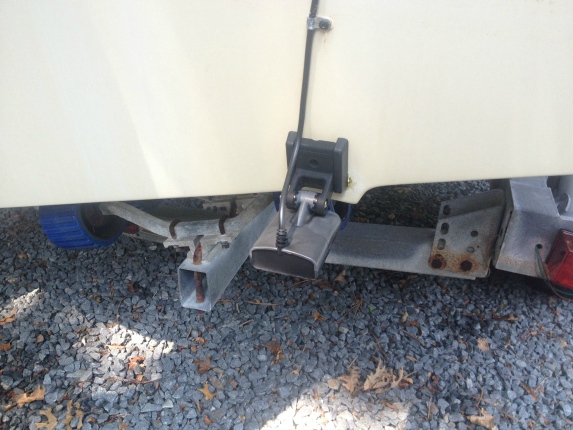
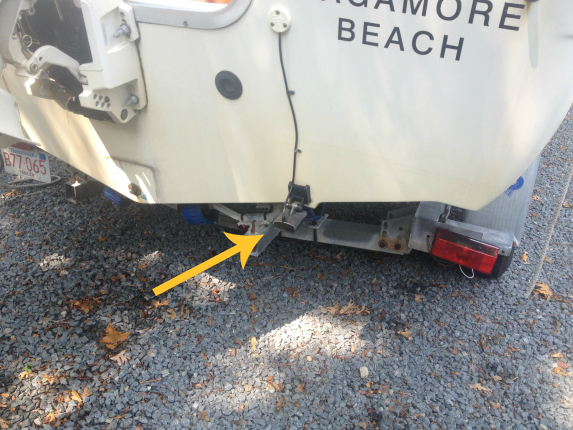
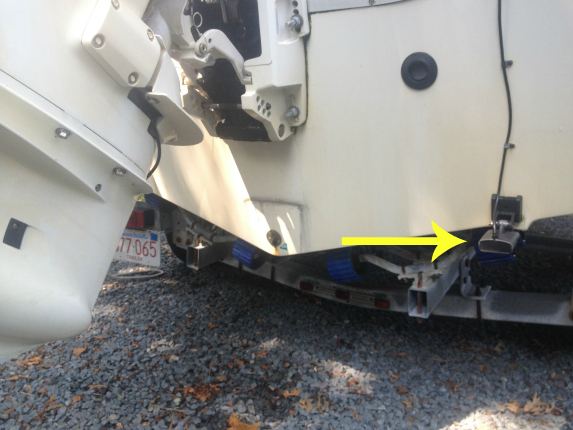
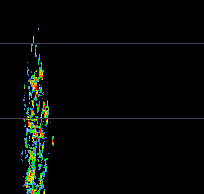
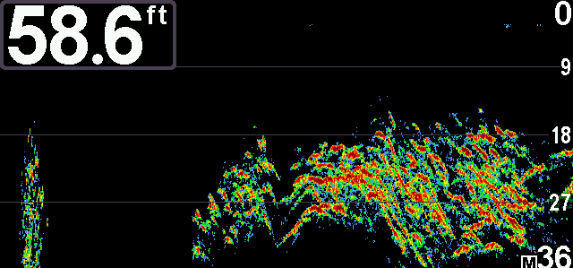
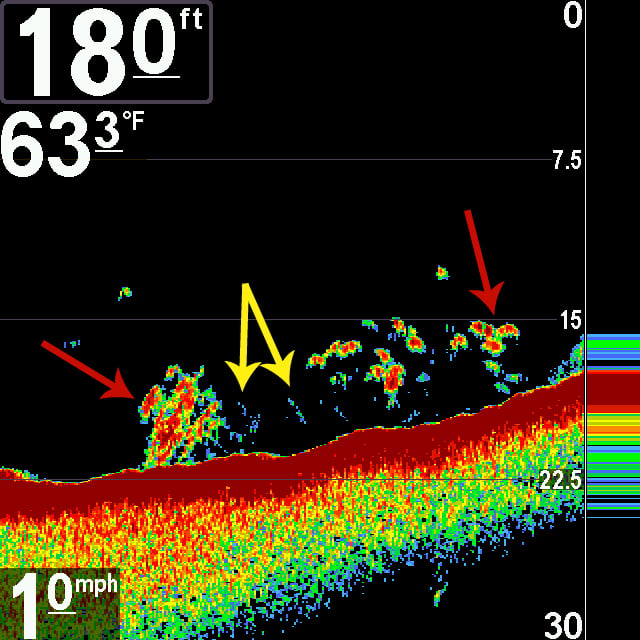
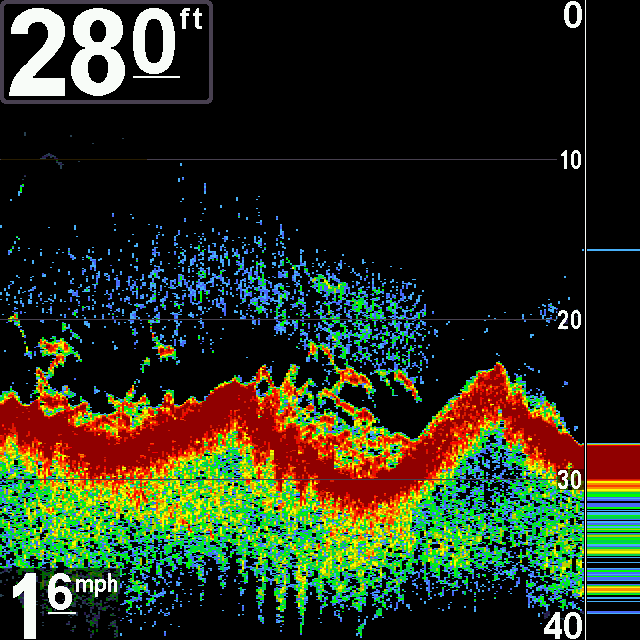
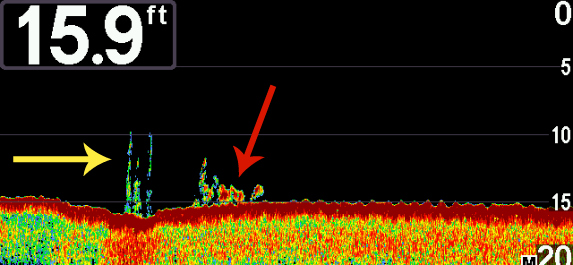
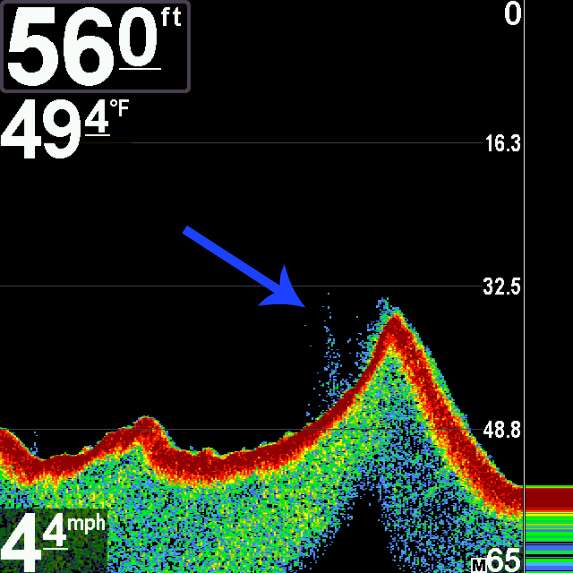

Definitely like to know more about side scan and clearview sonars
Roger that Colin. Here’s another article I wrote about side scan, in case you’re interested in checking it out. 👍
I have side sonar and I haven’t had it very long and I’m not sure how to read it I would love it if you could give me some information about it and thank you for the information about the fish finder it was really helpful and I welcome more information about how to read the images
Sounds good James! Here’s another article I wrote about side scan, in case you’re interested in checking it out. 👍
Thanks Ryan. Very insightful.
No problem David. I’m glad you found the post helpful!
Great information Ryan, I’d love to have more on sonar for sure! Thanks!
Excellent lesson Ryan I would like to know how to set my chirp . I have a Lowrance HDS Gen 3 that has 3 settings low , medium , and high what do I use and when ? Is it all about depth?
Regarding chirp Frank, I am not really sure. I believe I have mine set to medium, and that is where I leave it. I’d recommend doing a little experimenting in shallow versus deeper water. Let us know what you find out! ?
Great lesson on sonar, would love to see more examples of fish & structure. Thanks again,
Lt.805
Sounds good Gerald. I’ll keep that in mind for future lessons. ?
Just became a new member and this was a great read Look foward to getting more knowledge
Awesome to have you onboard as a member Mike! ? Keep me posted with how things are going. Spring is coming!
Hey Ryan,
Great lesson on sonar! Yes, more in depth info. on sonar and side scan would be great.
Tight Lines
Dave
Sounds good! A side-scan lesson may be in the works soon…
Thanks Ryan. Very helpful overview. I have a new Garmin Chirp for this spring. I’d be interested in learning more about how you approach marked fish, i.e. do you drop a line from directly above, cast from a short distance, and any other tips about the “Now what?” part of marking fish on sonar.
Larry
Hey Larry ?Glad you enjoyed the article and found it helpful.
To answer your question, it depends on the situation, but oftentimes I will work to keep the boat directly over the fish and drop lines right to them. This is especially true if fishing with live bait.
Other times if there is a strong current, I will mark fish on my sonar and then motor up-current a bit. Then I will let the current take the boat and drift over the fish.
And if I am trolling, then I will mark fish on my sonar and then motor past them just a hundred yards or so, set my trolling lines in the water, and then troll through the area I just marked them.
Do you have any experience with how other species like bluefish or black sea bass show up on sonar?
Hi David ?Yes I do have some experience with other species. In general, the smaller the fish, the more blue it will appear. Slightly larger will appear green. Sometimes big bluefish will register as orange/yellow. If the black sea bass are grouped tightly together, then occasionally they will register as orange on the sonar. I hope this makes some sense and isn’t confusing you!
Below is an example of tautog on my sonar. We had A LOT of tautog underneath the boat when this sonar snapshot was taken.
Wow I always thought tautog were impossible to mark on the sonar??
Not at all! Very possible to mark tautog. ?
Great great information you provide but myself being a newbie certainly have gained a wealth of knowledge by YOU and all our Members as you can tell by the numbers of visits to the various forums. Hopefully in time I can contribute once I learn how how to doi it. In the future help !
Happy to help David! Please keep me posted with how your 2019 season unfolds. I think it will be a good one for you! Have fun ✌?
Hello! Awesome info! But I have a Garmin301c and dont think has help me at all. May b is that the fish dont bite? But I haven’t really mark a spot and caught any fish because of the fish finder? I set up the fish alarm and averytime it beeps we send the bait but no bites?? May b is my presentstion of the bait?? Wen I go with the charters I come back with fish!! Now I have my own 19ft bayliner and only come home with 4 porgies?? Lol. May b I need one day fishing with Capt. Ryan!! I’ve been studying on MFCC and tomorrow im heading out at 3AM. Lets see if I learn anything!!??????
There is certainly much more that goes into the equation than just the sonar! That is for sure. It’s a helpful tool but it’s not the “end all be all” so to speak.
Like you mention, it certainly could be your presentation or a variety of other things. Of course, sometimes I mark fish and can’t get them to bite no matter what I do 🙂
Gluck out there and catch ’em up.
Thanks!! It was a great day at the bay but the fish weren’t biting no luck at all. My fish finder show me just like you said in the (9:30 in-person class recording) fishing by boat!! They were just cruising at 45ft. On 55ft of water!! You could see a line activity of a big long school from 45ft to 35ft. But they just weren’t biting!! I got some 17inch fluke but that was it!! Lots of mackerel but no stripers!!:-(
Im going back out there tomorrow Wednesday hopefully I get my first striper of the season!! Thank you for replying!:-)
No problem and have fun!
Anyone using sonar with chirp waveforms? I know from my military electronics background that chirp waveforms generally are aimed at higher resolution, but that is in a radar setting. Not used to seeing chirp with sonar and would love to hear anyone using it and contrasting it with conventional downward looking sonars. Lowrance HDS Gen 3 I hear provides chirp with its baseline sonar.
Very interesting…does a chirp sonar let you see what’s in front of the boat?
No, Ryan, chirp enables fine grained resolution of objects ….it uses the same (or similar) transducers as earlier generation sonars. I’ll see if I can find a write-up by Lowrance.
I’m doing something wrong. I have a new Garmin unit (1040xs) bought this year with downscan and side scan and updated my traditional in-hull transducer. I thought it was good until I read this article and saw your photos. I cannot get any readings beyond about 10mph. I expect this is partly because I’ve stuck with the sensitivity defaults (is this the same thing as “gain”?). Do you have to set the sensitivity/gain lower to get readings at higher speeds?
Hey Jim! Yes, first try to lower the gain/sensitivity settings until you get a clear picture.
The gain/sensitivity does not have to be set very high at all to mark fish like striped bass.
Let me know how that works! Hopefully it is a simple fix.
I have problems with my Lowrance combo. I guess is getting old. Yesterday I ordered a Deeper and today I tried it. It doesn’t work and I would get another one tomorrow. Did you hear about this product before?
Never heard of a Deeper before. What is it???
Ryan
Good article. I have a Humminbird combo and use side scan extensively but results are mixed. I use stern mounted transducer which came with unit.
When in 30′ depth I start with 3:1 (or less depending on water) ratio to sidescan to set range on each side and all is well on board. As the depth increases clutter starts to appear on display. Fish are now smaller due to scale being used and identification becomes a guessing game.
Appreciate any comments in your upcoming article.
Sidescan definitely takes some getting used to.
For simplicity sake, I keep the range on each side to 164 feet, no matter the depth I am in. Seems to work out OK for me.
I just published the next article today so let me know what you think, and best of luck out there this week.
good information on sonar use…thanks
No worries John, happy to help
Ryan, would definitely like to hear your thoughts on side-scan. I’ve been using a Lowrance w/down scan imaging and have generally frustrated by the lack of coloration. Fish are just specks on the screen and easy to miss. Weeds, fish holding bottom, and baitfish are almost impossible to distinguish. Anyway, I may be in the market soon and trying to learn more… Thanks
Sounds good – I will publish a post this week on side-scan.
Have you fooled around with the sensitivity settings Chris?
I used to have a Lowrance and it worked well, but each model is different of course.
Thanks Ryan. I have a bit and am finding certain color combinations and sensitivity do pickup density quite well. Noticed a diamond jig today showing up on image and also showed a streak as it moved. I need to find schools of bass and see if they’re distinct.
Gotcha. Yeah it definitely takes some getting used to and it’s pretty amazing how sensitive the sonars can be.
I have a feeling you’ll instantly know when you finally mark a big pile of bass. Perhaps off Billingsgate when you make your trip in August.
Ryan, would definitely like to hear your thoughts on side-scan. I’ve been using a Lowrance w/down scan imaging and have generally frustrated by the lack of coloration. Fish are just specks on the screen and easy to miss. Weeds, fish holding bottom, and baitfish are almost impossibly to distinguish. Anyway, I may be in the market soon and trying to learn more… Thanks
Ryan,
Great article on using sonar. Though I’ve been fishing surf forever, I’m a boating and sonar newbie . You articles help a lot ! Thanks keep it up. I would also enjoy a a follow up “using sonar” article.
Tight lines All!
Dennis B
Thanks Dennis, I’m happy you got some value from this post.
I will definitely publish a follow up article this week – thanks!!!
Hey Ryan….excellent info. Sonar 201 would be greatly appreciated.
Sounds great Steve – thanks as always!
It’s not pertinent to me me at all but good fodder for the memory bank, thanks for the primer!
Sounds terrific Art!
yes all information on sonar is invaluable. thx for the post
Sounds great John, thank you for the input